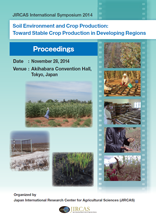Soybean Yield Is Affected by Previous Crops and Mycorrhizal Fungal Colonization Under No P Fertilizer Condition, A Japanese Study with Applicability to Developing Regions

At present, all phosphoric acid fertilizer materials are obtained from imported phosphate rock, but
since the global phosphate rock reserve is decreasing, alternative techniques to supply the plant
phosphorus must be developed. Arbuscular mycorrhizal fungi (AMF) symbiotically inhabit the cortical
cells of vascular plant roots. These fungi absorb phosphorus and other nutrients from the soil
facilitating the uptake of these nutrients by host plants. Utilization of this natural relationship may be
beneficial for crop production especially that of leguminous crops whose roots absorb phosphorus
poorly as compared with gramineous crops. The maintenance of AMF spore density in field soil is an
important criterion for enhancing crop production. AMF spore density and colonization have been
shown to increase following the cultivation of AMF host crops. We evaluated how the cultivation of
AMF host (wheat) and non-host (rapeseed) crops affects the subsequent soybean crop by assessing
AMF spore density and AMF colonization, phosphorus uptake by soybean and yields of soybean over
a four-year period. Every year wheat or rapeseed was cultivated from autumn to spring and soybean
from spring to autumn under no P2O5 fertilizer condition. From the first to fourth year, AMF spore
density was higher in the plot after the cultivation of wheat (wheat plot) than in the rapeseed plot.
From the second to fourth year, the AMF colonization ratio was higher in the wheat plot than in the
rapeseed plot. In the first year, there was no difference in the AMF colonization ratio, growth, and P
uptake by soybean plants between the rapeseed plot and wheat plot. However, from the second year to
fourth year, AMF colonization ratio, plant growth, and P uptake by soybean in the wheat plot were
higher than those in the rapeseed plot. The soybean yields in both plots gradually decreased from the
first to fourth year. Furthermore, in the second and the fourth year, soybean yields were higher in the
wheat plot than in the rapeseed plot. There was a significant correlation between the AMF colonization
ratio and soybean yield. Therefore, we concluded that AMF colonization is not determined by AMF
spore density alone, with other factors influencing the AMF colonization of subsequent soybean plants.
And that it is important to increase the AMF colonization ratio to increase soybean yield under no
P2O5 fertilizer condition. And AMF will be useful for P2O5 absorption of crops in developing countries.
| 刊行年月日 | |
|---|---|
| 作成者 | Katsunori Isobe |
| 著者キーワード |
Arbuscular mycorrhizal fungi Cropping system No P2O5 fertilizer condition Soybean (Glycine max Yield. |
| 公開者 | Japan International Research Center for Agricultural Sciences |
| オンライン掲載日 | |
| 号 | 2014 |
| 開始ページ | 92 |
| 終了ページ | 100 |
| 権利 | Japan International Research Center for Agricultural Sciences |
| 言語 | eng |
